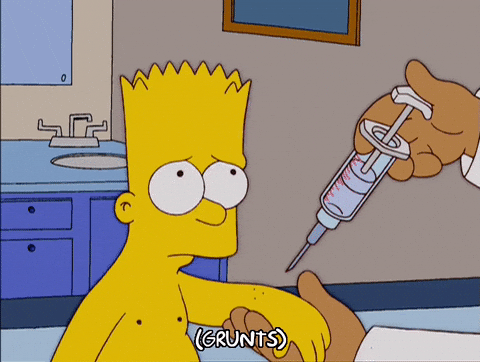
Even though I’m nowhere close to being old, I’m not incredibly young anymore, either. What this boils down to is, over the span of time that I’ve been on this planet, I have definitely seen some things that make it pretty hard to totally catch me off guard — especially when it comes to Black women and what we are fully capable of in the beauty department. Oh, but when I tell you I had to do a few triple-checks on this post right here? Y’ALL.
Okay, did you peep the text? 60. Umm...60?! Y’ALL. I know we say that “Black don’t crack” ‘n all, however, this is taking things to an entirely different level. And even though I’ve been on-10 about my skin, even before this woman had me damn near mesmerized, I won’t lie — she further confirmed to me why it’s so important to be hypervigilant and super proactive when it comes to consistent and effective skincare. And as of this year, for me, that includes implementing at-home chemical peels.
If you’ve never considered getting a chemical peel before, let alone giving your own self one, stay tuned. I’m gonna touch on all of the things you’re (probably) curious about in order to put your mind at ease so that your skin can be at least half as amazing as this woman’s skin is (lawd!).
What Is a Chemical Peel?
Okay, so let’s start at the beginning. A chemical peel is a process that consists of applying certain acids to your face that will help to remove certain layers of your skin (depending on what kind of acids you use and what concentration you apply) in order to remove dead skin cells, seriously clear out your pores, get rid of hyperpigmentation (over time), soften the appearance of acne marks/scars, fine lines and wrinkles and give your skin a fresh, youthful and glowing look.
For the most part, chemical peels are broken down into three different types:
Light (lunchtime) peel: This peel removes the very top layers of your skin, can be done from the comfort and convenience of your own home, oftentimes consists of very little (if any) skin shedding, and requires no downtime. It’s also relatively painless.
Medium peel: Here, both the upper and middle layers of your skin are removed. People with age spots, acne scarring, severe hyperpigmentation, and somewhat prominent wrinkles may opt for this one. It takes around a week for your skin to fully recover; there is some shedding, and yes, some downtime is required. This kicks the discomfort up a couple of notches (because the acid is stronger).
Deep peel: If you’ve got the kind of acne marks that leave pits or indentations in your skin, there are a good amount of wrinkles and crow’s feet hanging around, or you want a really drastic change in how your skin looks and feels, this is the type of peel that can make that happen for you. Now, this one is where the big kids play. In fact, some professionals will prep your skin for up to eight weeks before even applying this type of peel. The shedding is so extreme that it just might freak you out, and you’re absolutely gonna need to settle in for some downtime. In fact, you may be given some pain medication to handle this one.
As far as the kind of acids that are used in chemical peels, one of the following (or a combination of them) is customary:
- Glycolic acid
- Trichloroacetic acid
- Salicylic acid
- Lactic acid
- Phenol
If you were to do these at home, you can buy them at different concentration levels. For instance, the company that I have quickly become a fan of is Perfect Image. They’ve got peels and peel pads in different chemical forms and concentration levels from 10-50 percent so that you can ease into what works best for you and possibly “build up resistance” (to the chemical levels over time).
If there’s a part of you, that’s skeptical because of your complexion (because there are some people who are haters of brown and Black skin using chemical peels) — that’s part of the reason why I enclosed all of the videos in this article; it’s to provide you with proof that yes, we can use chemical peels, just like everyone else. The main thing to keep in mind is that if you’re going to get a professional chemical peel, you should go to a dermatologist or esthetician who actually specializes in melanated skin.
You should also watch videos like the one here via Destiny Lashae Makeup's YouTube channel. It’s an almost 24-minute video that walks you all the way through a deep chemical peeling process so that you know just about all that you would be getting yourself into with that type of peel.
This brings me to my next point about chemical peels.
Why You Should Let a Professional Do a Certain Kind of Them
This brings me to my next point about chemical peels.
If you watched the video that I just mentioned or even the one featured in that section, you can tell that deep (and sometimes even medium) chemical peels ain’t nothin’ to play with on your own. For starters, the process consists of more than just slapping some acid on your face and going about your merry way. A professional has to study your skin to see what chemicals would work best for you; there are other products that need to complement the peel and the downtime…yeah, the downtime.
Plus, you need self-control times a billion to let the peel fully do its process because, if you pick at the peel prematurely, that can be counterproductive as hell in the sense that it could lead to infection, hyperpigmentation, or even permanent scarring.
And if you’re wondering what a professional chemical peel would run you…yeah, that part. Let’s just say that it’s not the cheapest thing on the planet. The average (because some are much lower and some go into the thousands) is somewhere around five hundred bucks for a really thorough deep peel. The good news about that is oftentimes, you only have to go once for one of those. And that price tag is certainly not the only option. My waxer is also an aesthetician, and her chemical peels are around $150 per session.
If all of this is still too deep for your pockets (trust me, I totally get it), another option is to do what I do: my own chemical peels at home.
The Pros of Doing Chemical Peels at Home
Due to the fact that I am a reformed product junkie, I actually don’t mind experimenting a bit with my skin and hair. So, as I was seeing at-home chemical peels pop up in my YouTube algorithm a while back, I took that as a clear sign that I needed to give one a try. I’ll be honest, I probably should’ve gone with something that was 10 percent concentrate first, yet, for the cost, I decided that I would give 30 percent a shot.
I first went with the lactic acid peel, mostly because I already knew that it was an alpha hydroxy acid that is effective at removing dead skin cells (my skin can get pretty dull if I’m not careful) and lightening dark spots. Lately, though, I’ve been playing around with a pineapple pumpkin enzyme peel because the brand that I use combines lactic and glycolic acid (it’s great at treating acne, acne scars, and getting rid of dark patches along with removing dead skin cells too); plus, pineapple is loaded with vitamin C and can help to brighten your complexion while pumpkin contains vitamin E and is an awesome skin hydrator.
Anyway, since using both these peels, here are the “pros” that I have noticed:
- Not a ton of skin-prepping is required (although you need to thoroughly read and follow the instructions of whatever product you decide to use).
- The peels are easy to apply.
- The stinging (at 30 percent, not 10) is quite manageable (although you do feel it).
- Cool water can typically “deactivate” the peel (although adding baking soda to the water is super effective).
- My skin immediately looks and feels smoother and “tighter.”
- I only get period pimples for the most part, and those have decreased, significantly so.
- Any unevenness is fading.
- Other skin products glide on so much easier.
- My pores appear smaller.
- I can use the peel 2-3 times a week (be careful to build up to that level of tolerance).
- My skin glows (also almost immediately after use) like it’s radiant.
- My skin does not shed (although there can be minimal amounts based on higher concentrations).
- I have virtually no sebum plugs (at least that I can feel or see).
Yeah, I ain’t got no lies to tell you — as far as skincare moves are concerned, applying LIGHT at-home chemical peels has been one of the best decisions that I have EVER made.
No exaggeration; especially when it comes to the price (the bottles that I get are designed to last me for around 20 peels at less than 30 dollars a bottle).
Now, that doesn’t mean that the path to all of what I just mentioned has always been smooth…
The Cons of Doing Chemical Peels at Home
Right now, as we speak, I’ve got a burn scar on the left side of my mouth that is still healing (as far as hyperpigmentation goes). How the heck did it get there? Because I didn’t follow parts of the advice that I’m giving you. Because a part of what affects the impact and effectiveness of a chemical peel is not just the concentration of the acid but how long you leave it on your skin — when I first tried the enzyme one, I thought I was big and bad, and so I left it on, at 30 percent, for five minutes…the first attempt. I caused a minor skin burn. Then, when it started to come off, I thought it was a skin peel and not a burn, and that resulted in a scar. SMDH.
All of this was totally my fault. Still, that doesn’t mean that I shouldn’t give you a heads up on a few things on the potential “cons” side of chemical peels:
- Even if you read the instructions, there is some trial and error involved.
- Because you’re winging it on your own, you might discover the hard way which kinds of acids actually work in your favor and which ones…don’t.
- Sometimes, it can be hard to know the difference between the kind of stinging that’s working for you (“eating up” the dead skin cells) vs. working against you (actually burning your skin).
- If you’re not careful, you could end up with some post-inflammatory hyperpigmentation from mild scabs or burns that can take quite a bit of time to heal.
- The results are not nearly as drastic as medium and deep chemical peels (although how many layers you apply and how long you leave a light peel on will determine things like dryness and peeling).
- There can be some temporary itchiness following applying the peel for a couple of days that will lead to mild scarring if you scratch.
- You need to apply the peels consistently for the best results (one-and-done is futile).
Aside from those seven points, you also may go through a bit of skin purging, which isn’t a whole lot of fun. Since chemical peels are basically detoxing your skin, it’s not uncommon for your face (or wherever you’re applying the peel) to first look magnificent and then, after a couple of weeks, to have some breakouts due to the toxins and bacteria that are rising to the surface. Indeed, it does take a bit of patience to get through that process (especially if you keep starting and stopping the peels), yet I’m a living testament to the fact that it will pass, and the skin that you get on the backside will make it all well worth the time, effort and energy.
_____
Hopefully, I explained chemical peels enough to where, if you are considering a professional one or going the DIY route, you know what you’re getting yourself into. Like I already said, I am a fan and wish I had known about them sooner. Few things have blessed my skin more, y’all. And I totally mean that.
Now, let me go apply my peel for the day. Yay! It’s time.
Let’s make things inbox official! Sign up for the xoNecole newsletter for daily love, wellness, career, and exclusive content delivered straight to your inbox.
Featured image by yacobcuk/Getty Images
This Is How To Keep 'Holiday Season Stress' From Infecting Your Relationship
Hmph. Maybe it’s just me, but it seems like there is something really weird happening in the fall season air (because winter doesn’t officially begin until December 21) that cuddle season is in full swing while break-up season is as well. In fact, did you know that break-ups are so popular during the holiday season that December 11 is deemed Break-Up Day?
The reasons why relationships shift around this time vary; however, I did both roll my eyes and chuckle when I read that a very popular one is because it’s an easy way to get out of getting one’s significant other a Christmas present. SMDH.
Anyway, I personally think that the less shallow folks out here may contemplate calling things “quits” or they at least distance themselves a bit from their partner (and what I’m referring to is serious relationships) due to all of the stress and strain that oftentimes comes with the holidays whether it be financial, familial, due to their tight schedules or something else.
Listen, I would hate for you and your man to miss the fun and happiness of experiencing this time of year, all because you are so overwhelmed or irritated that you can’t really enjoy it. That’s why I have a few practical tips for how to avoid allowing the typical holiday season stress from INFECTING your relationship.
Manage Your Expectations
 Giphy
GiphyUnmanaged expectations. If there is a main reason why the holiday season tends to be so stress-filled for so many people, I’d bet good money that this is the cause. And when you’re in a long-term relationship, expectations can manifest themselves in all sorts of cryptic and/or unexpected ways. You might have relatives who assume that you are going to be with them for Thanksgiving or Christmas when you have other plans in mind. You might be thinking that you are going to spend one amount for presents while your man is thinking something totally different. When it comes to scheduling, your signals may be crossed.
And you know what? To all of these scenarios, this is where clear and consistent communication come in. Don’t assume anything. Don’t dictate anything either. From now until New Year’s, mutually decide to check in once a week, just to make sure that you are both on the same page as it relates to the holidays and what you both are thinking will come along with it. The less blindsided you both feel, the less stressed out you will be. Trust me on this.
Set (and Keep) a Budget
 Giphy
GiphyOkay, so I read that last year, 36 percent of Americans incurred some type of holiday-related debt. Hmph. Last year, there was still some sense of normalcy in this country, chile, so I can only imagine what finances are gonna look like over the next several weeks. That said, since I don’t know a lot of people who don’t find being broke stressful, make sure that you and your bae set a budget and then stick to it this year — no ifs, ands or buts.
Because really, y’all — it doesn’t make sense to deplete savings and/or max out credit cards for a few days of giggles only to be damn near losing your mind because you don’t know how to make ends meet come Dr. Martin Luther King, Jr. Day.
And by the way, this tip doesn’t just speak to things like food and gifts; I also mean travel. If it doesn’t make a ton of sense (or cents) to be all over the place this year — DON’T BE.
Keep Matthew 5:37 at the Forefront
 Giphy
GiphyIf off the top of your head, you don’t know what Matthew 5:37 says, no worries, here ya go: “But let your ‘Yes’ be ‘Yes,’ and your ‘No,’ ‘No.’ For whatever is more than these is from the evil one.” That verse right there? Oh, it’s a boundaries lifesaver! I say that because do you see “maybe” or “I’ll think about it” in there? Nope. LOL. It says that you should tell people “yes” or “no” and leave it at that — and that complements Anne Lamott’s quote, “’No’ is a complete sentence” impeccably well. Yeah, you’ve got to remember that anything beyond a yes or no to a request is privileged information; you don’t owe anyone details or an explanation.
Besides, if you are really honest with yourself, when someone asks you something and you give a “Umm, let me think about it” kind of reply, more times than not, you already know what your answer is going to be — so why not let you both off of the hook? Give your response. Commit to that. And let everyone (including yourself) get on with their lives and schedules.
I promise you that when it comes to those holiday parties, you are pissing more folks off by not RSVP’ing or doing so and not showing up than just saying, “Thank you but not this year” off the rip.
Remember That Your Personal Space Is Privilege Not a Right
 Giphy
GiphyA friend of mine recently bought a new house and invited me over to come see it. He’s a single man with no children, so as I was taking in all of the space that he had, especially as I walked through his finished basement, I joked about relatives coming to live with him. “Hell no” and “absolutely not” were pretty much his immediate responses as he went on to say that some folks even had the nerve to be offended when he told them that he had no intentions on taking DNA in.
Ain’t it wild how people think that your stuff is their right? And yes, that brings me to my next point. Your home is your sanctuary space. If you want to host folks this year — cool. If not, ALSO COOL. Please don’t let folks (family included) guilt you into how they want you to act or even into what they would do if the shoe was on the other foot. You are not them — and as one of my favorite quotes states, “If two people were exactly alike, one of them would be unnecessary.” (A man by the name Larry Dixon said that.)
Hell, my friends? They know that I am good for sending them random things that they need or even want all throughout the year. Coming over to hang out at my pace, though. Uh-uh. Chalk it up to being a card-carrying member of the ambivert club yet I like keeping my living space personal — and I sleep like a baby, each and every night, for feeling that way.
Always remember that your space, your time, your resources, your energy and shoot, yourself period (including your relationship), are all things that are your own. You get to choose how, when and why you want to share them. The holiday season is certainly no exception.
Cultivate Some “You Two Only” Traditions
 Giphy
GiphyIt’s not uncommon for some couples to hit me up after the holiday season to “detox.” Sometimes it’s due to the financial drama (and sometimes trauma) that they experienced. Sometimes it’s because they allowed their relatives (especially in-laws) to get more into their personal business than they should’ve. More than anything, though, it tends to be because they didn’t get enough quality time together and so ended up feeling “disconnected.”
Please don’t let that happen. Listen, I’m not even a holidays kind of woman and yet, I will absolutely sit myself down with some hot chocolate and chocolate chip cookies to enjoy a Hallmark holiday film or two. Aside from the fact that most of them are lighthearted and sweet, I also like that they usually focus on couples loving on each other amidst all of the holiday beauty and ambiance — which is something that all couples should set aside some time to do.
Maybe it’s a vacation. Maybe it’s a staycation. Or maybe it’s my personal favorite, A SEXCATION. Whether it’s for a few days, the weekend or even overnight — don’t you let the holidays go by without setting aside time for you and your man to celebrate one another. Don’t you dare (check out “Are You Ready To Have Some Very Merry 'Christmas Sex'?”).
GET. SOME. REST.
 Giphy
GiphyI once read that 8 out of 10 people get stressed out over the holidays and 3 out of 10 lose sleep during to it — and when you’re stress-filled and sleep-deprived, that can absolutely lead to hypersensitivity, making mountains out of molehills and even not being in the mood for sex.
Your relationship can’t afford to go through any of this, so definitely make sure to prioritize rest. I don’t care how unrealistic it might seem during this time, sleep should never be seen as a luxury; it will always and forever be a great necessity.
That said, try to get no less than six hours of shut-eye in (check out “6 Fascinating Ways Sex And Sleep Definitely Go Hand In Hand”) and even ask your bae to take a nap with you sometimes (check out “Wanna Have Some Next-Level Sex? Take A Nap, Sis.”). Not only will sleep help to restore your mind, body and spirit but, when it’s with your partner, it’s an act of intimacy that can make you both feel super connected, even in the midst of what might feel like chaos.
___
Holiday season stress is real. Still, never give it the permission or power to throw your relationship off. Put you and your man first and let the holidays be what they are gonna be, chile.
Let’s make things inbox official! Sign up for the xoNecole newsletter for love, wellness, career, and exclusive content delivered straight to your inbox.
Featured image by Shutterstock
While doing a podcast interview a couple of weeks ago, when I said my age, the interviewer complimented me by saying that what I said is not what they would’ve guessed. When they asked what the secret was, the first thing that came out of my mouth was, “Oh, I’m gonna take me a nap.”
I adore sleep. I’ve said before that it’s like what Six Flags is to some people. And really, it’s just a plus that there are so many health benefits from getting plenty of rest. Beauty-wise, science does reveal that getting no less than seven hours a night can slow down signs of aging. Know what else? There are some direct things that sleep — and the lack thereof — can do to your immunity as well.
And so, since this is the time of year when catching a cold (and/or the flu) is common, let’s talk about the impact that sleep (and again, a lack thereof) has on your immune system. That way, you can remain as healthy as possible during the fall and winter seasons.
1. Less Sleep Means More Colds
 Giphy
GiphyLike I stated in the intro, I’m pretty sure you’ve heard somewhere that the fall and winter are the seasons when people are most susceptible to catching a cold or coming down with the flu. And that’s exactly why I thought I would start this all off by sharing the fact that some studies reveal that if you get less than six hours of sleep, on a consistent basis, you end up making yourself more vulnerable to coming down with both. In fact, some research says that only 18 percent of people who get six-plus hours of rest caught a cold while almost 40 percent who got less than that did.
The logic behind it all is sleep gives your body time to build up the proteins and cells (like cytokines and T-cells) that you need to fight off certain viruses. So, if nothing bothers you more than having a stuffy nose or stubborn cough when it’s cold outside, getting more sleep is one way to prevent that from happening to you.
2. Less Sleep Means More Allergy Symptoms
 Giphy
GiphyAt the end of the day, an allergy is basically what transpires whenever your immune system “overreacts” to something that other people’s systems do not. And since sleep is what helps to keep your immune system nice and strong — well, I’m sure you get how less allergy-related symptoms and more sleep go hand in hand. Also, since sleep helps to decrease bodily inflammation (more on that in a bit) and inflammation can also intensify allergy symptoms, that’s just one more reason to get as much shut-eye as possible.
3. Less Sleep Means Potential Diabetes and Heart Disease
 Giphy
GiphyDid you know that in 2024, Black women were diagnosed with diabetes 24 percent more than any other adult demographic. Also, it continues to be a reality that heart disease is the leading cause of death for Black women. These two sobering statistics alone should be enough of an incentive to do whatever you can to keep the risk of diabetes and heart disease way down.
One way to do that is by getting more sleep. Aside from the fact that sleep strengthens your immune system to where it is easier for you to fight off illness and diseases, sleep can keep your blood sugar levels in a healthy space; plus, when it comes to your heart, it gives it, along with your arteries and blood vessels a break.
4. Less Sleep Means Less Time for Your Body to Push “Reset”
 Giphy
GiphyIf you really stopped to consider all that your body goes through during the day (you can read some about that here), you definitely would respect it enough to do your best to thank it by giving it no less than six hours of sleep, each and every night. Sleep is what helps to slow your brain and body down so they are able to “refuel” for the next day. After all, how can your body prevent you from getting sick if your immune system is too worn out to fight ailments off? Exactly.
5. More Sleep Helps You to Fight Off Infections
 Giphy
GiphySpeaking of, in order for your body to fight off infections, there are certain cells and antibodies within you that need to be healthy and strong — one way that they get and stay that way is by you getting a good amount of sleep. For instance, remember when I touched on cytokines earlier? Well, the same way that they help to prevent colds, they also help to prevent infections too. And since sleep lowers your cortisol (stress) levels, rest gives your body the time and space to build up an army that can fight off free radicals and other health-related challenges while you are awake.
6. More Sleep Lowers Bodily Inflammation
 Giphy
GiphyWhenever a health-related issue is mentioned on this platform, inflammation is something that is mentioned quite a bit. Probably the easiest way to explain inflammation is it’s how your body responds/reacts whenever something is happening to your body that shouldn’t be, whether it’s an illness, an injury, a germ or something that you may be allergic to.
If you happen to have chronic inflammation, some symptoms that are associated with that include fatigue, stiff joints, skin rashes, weight gain and moodiness.
The interesting thing about all of this is if you aren’t getting enough rest, you could be triggering inflammation in your body. That’s because studies reveal that a lack of sleep can elevate molecules that are associated with inflammation. So, if you don’t want inflammation to increase within your system, you should definitely catch more zzz’s.
7. More Sleep Regulates Hormones
 Giphy
GiphyWhen it comes to hormones like serotonin, estrogen and cortisol, believe it or not, they play a role in how your immune system acts and overreacts. That’s because, if your hormones are out of balance, that can cause your immune system to work harder than it actually should and that can make you more vulnerable to sickness. One way to keep your hormones leveled out? SLEEP.
That’s because sleep gives your body the opportunity to rest, repair and restore your hormone levels. On the other hand, when you are sleep deprived, that can put/keep your hormones on the ultimate roller coaster ride. #notgood
8. More Sleep Strengthens Vaccines
 flu shot GIF - Find & Share on GIPHYGiphy
flu shot GIF - Find & Share on GIPHYGiphyIf you’re someone who is good for getting some sort of vaccine around this time of the year, make sure that you rest up before and after getting your shots. Not only does adequate rest before a vaccination help your immune system to be better receptive to your shots but sleep also helps your body to build up enough antibodies to make your vaccinations effective after getting them. Because if you’re gonna get pricked, shouldn’t it be worth it? My thoughts exactly.
Get some freakin’ sleep! Your immune system depends on it.
Let’s make things inbox official! Sign up for the xoNecole newsletter for love, wellness, career, and exclusive content delivered straight to your inbox.
Featured image by Shutterstock









